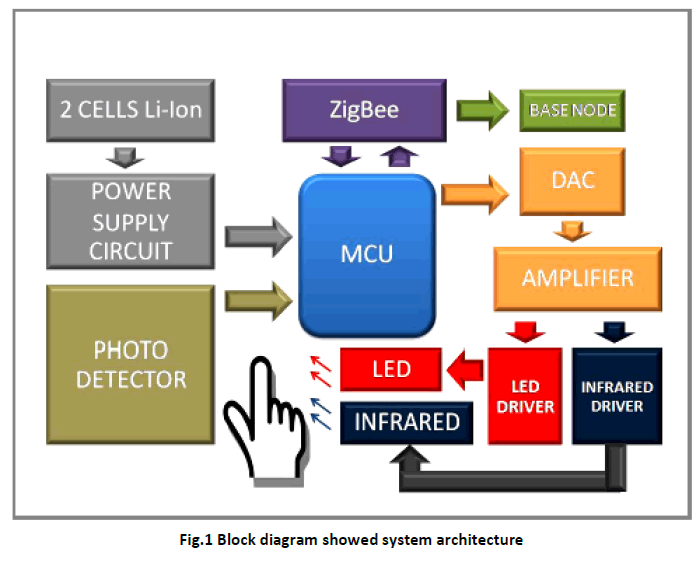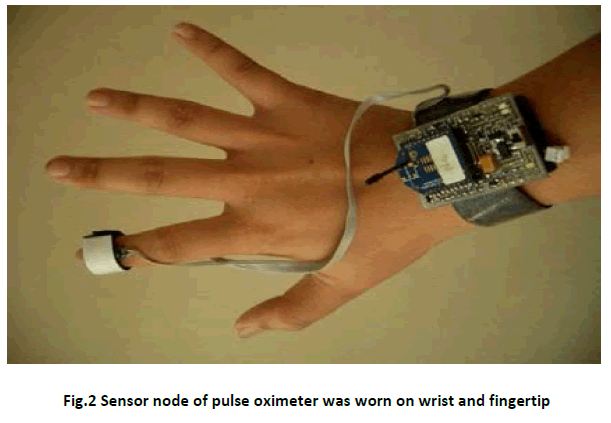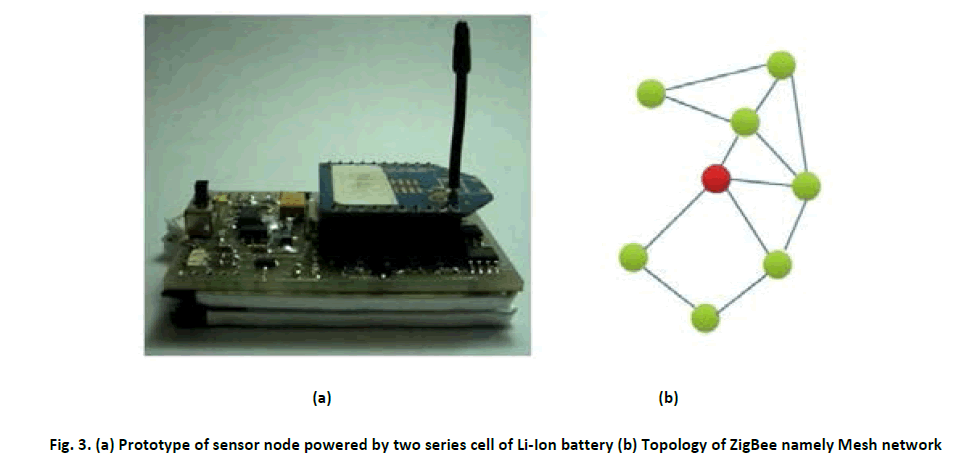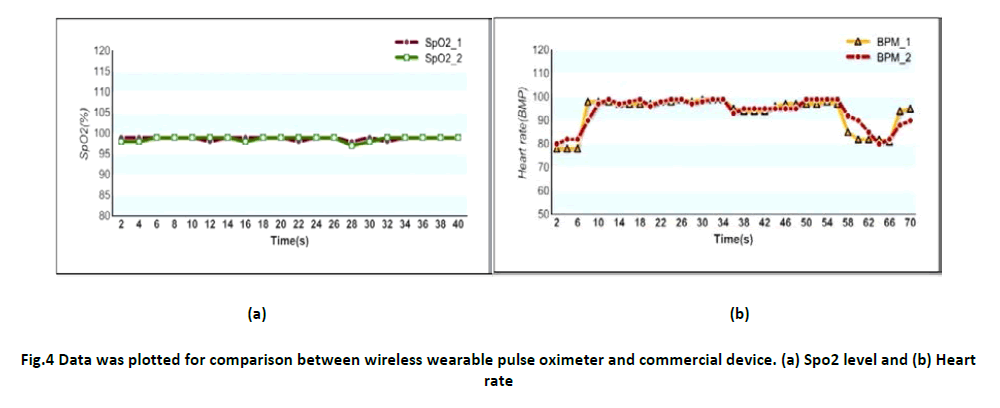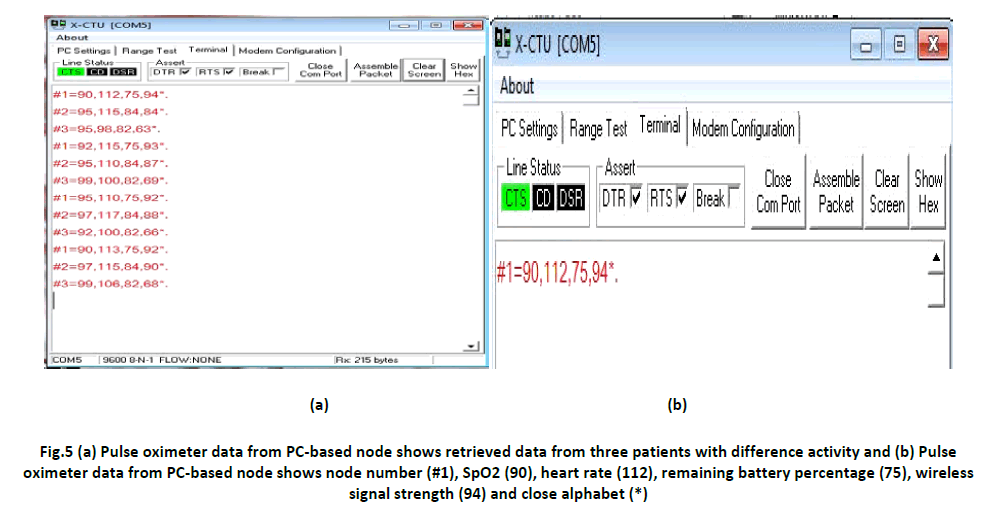Research Article Open Access
Real-Time Health Monitoring System on Wireless Sensor Network
Deepak Choudhary1*, Rakesh Kumar2 and Neeru Gupta31Associate Professor Galgoatia’s, University, India
2Director, K.P.Jain engg. College, India
3Asst. Prof, Mannav Bharti University, India
- *Corresponding Author:
- Dr. Deepak Choudhary
Associate Professor Galgoatia’s, University, India
E-mail: engg_deepak@yahoo.com
Visit for more related articles at International Journal of Advance Innovations, Thoughts & Ideas
Abstract
In this work, a portable real-time wireless health monitoring system is developed. The system is used for remote monitoring of patients’ heart rate and oxygen saturation in blood. The system was designed and implemented using ZigBee wireless technologies. All pulse oximetry data are transferred within a group of wireless personal area network (WPAN) to database computer server. The sensor modules were designed for low power operation with a program that can adjust power management depending on scenarios of power source and current power operation. The sensor unit consists of (1) two types of LEDs and photodiode packed in Velcro strip that is facing to a patient’s fingertip; (2) Microcontroller unit for interfacing with ZigBee module, processing pulse oximetry data and storing some data before sending to base PC; (3) ZigBee module for communicating the data of pulse oximetry, ZigBee module gets all commands from microcontroller unit and it has a complete ZigBee stack inside and (4) Base node for receiving and storing the data before sending to PC.
Keywords
ZigBee, Sensor Networks, WPAN, Health Monitoring.
Introduction
Health monitoring systems become a hot topic and important research field today. Research on health monitoring were developed for many applications such as military, homecare unit, hospital, sports training and activity emergency monitoring system. In this paper, we developed the wearable and real-time monitoring system of some critical vital signs for elderly people, because Thai people who ages over 60 years old encounter accidental incidents over 60 percent. [1] That system may help doctor or people in family monitor the emergency alarm from patient or elderly people. The vital signs of health status that are the important parameter in health monitoring system consist of blood pressure, heart rate, oxygen saturation, body temperature and respiratory rate.[2] In this work, we consider two parameters of the vital signs which are heart rate and oxygen saturation in blood. That vital sign can measure by using device namely; pulse oximeter. The pulse oximetry data are important for doctor to monitor patient’s health condition.
The data helps to prevent and protect the oxygen lack in monitored patient’s blood stream. This condition will occurs when the brain does not receive enough oxygen is called cerebral hypoxia [3]. Moreover, pulse oximetry data can predict the patient’s disease and accident situation.
Wireless technology was developed in many applications that becoming a part of human activities such as agriculture, military, medical care, smart home system etc. Distinctly, wireless sensor networks (WSN) play a crucial role in such a monitoring system application, for the reason that WSN can offer some advantages over other types of wireless systems, especially its scalability, power management and flexibility of architecture. As a matter of fact, there are two popular standards in the wireless personal area network (WPAN), namely, Bluetooth and ZigBee. This work was focused on the capability of wireless sensor networks as an efficient tool to monitor health in term of pulse oximetry data for demonstration. This situation makes it difficult to develop and challenge because many applications in WSNs developed for fixing the position of member in wireless personal area network (WPAN). We adopted the ZigBee for using as a real-time health monitoring system on a patient.
In this research work, we developed a group of sensors for measuring pulse oximetry with real-time monitoring system based on ZigBee wireless network. The conventional pulse oximeter was a medical device that mostly expensive, wired and non-daily usage allowed. To reduce these problems, many methods were researched to overcome this barricade. The wearable pulse oximeter instruments have been reported by several groups and used in many applications. Hyon Young Han et al developed a wearable health monitoring device using many sensors [4]. Measurement of motion during ambulatory using pulse oximeter and tri-axial accelerometer was developed by Young- Dong Lee et al [5]. All wireless sensor hardware operates in point-to-point and do not allow for networking sensors with real-time patient movement monitoring.[6,7,8]Some reported works developed non-friendly usage and consumed much power to operate[9,10]. The developed real-time pulse oximetry monitoring system has a pair of light-emitting diodes (LEDs), One of LED has a wavelength in red and other one is in infrared region. The light was detected by a photodiode. The LEDs and photodiode was packed in Velcro strip that facing through a patient’s fingertip. The pulse oximetry data was kept and calculated by microcontroller unit. Pulse oximetry data was read every a second and stored on microcontroller. The data from microcontroller unit was sent to base node via ZigBee wireless network and stored on data-logging PC. The data from wearable pulse oximeter consist of SpO2, heart rate, wireless communication signal strength and battery voltage indicator data. Microcontroller hardware and ZigBee module were packed in suitable case which elderly people or patient can wear on their wrist. The rest of the paper is organized as followed. Section 2, we describe our approach to understand the principle of pulse oximeter. Section 3 and section 4; provide the design of wearable pulse oximeter which based on ZigBee wireless sensor network and wireless network technology used in this system. In section 5, the device and experimental result from that device was shown. The last section is discussion and conclusion.
Principle of Pulse Oximetry Measurement
Pulse oximetry is accomplished by implementing the Beer-Lambert Law [11], which, in this case, concentration of oxygen in the blood correlated to the amount of light absorbed when it is transmitted to the blood. The transmitted of light through the tissue (in this research we use fingertip) can be calculated using Beer-Lambert Law as follow Eq.
 (1)
(1)
Where Iout is the light intensity transmitted through fingertip tissue, Iin is the intensity of the light going into the fingertip tissue and A is the absorption factor. The fundamental of oximetry measurement is that blood has different optical properties at different levels of oxygen saturation. This means that if multiple sources of light at different wavelengths are used to examine the blood, they can be compared algorithmically by a processor to determine the level of oxygen saturation in the blood. The beauty of this concept is that the examination can be made non-invasively by passing light through an extremity of a finger. The light is collected by a light sensitive solid-state device, a photo-detector, or more recently a LTF (Light-o-Frequency) converter. Oximeter probes are designed to have multiple light sources (or different colors of LEDs) that are switched on/off during the measurement by the instrument. From this method, we can calculate the SpO2 and heart rate from detection of two kinds of light, in this work, infrared and red light are used. The signal from two kinds of light has both AC and DC component. From the AC and DC component from each of the wavelength need to be measured and the equation using for calculation is as followed Eq.
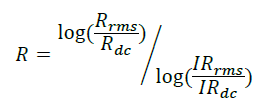 (2)
(2)
R is ratio between both light. In the same way; the SpO2 can be calculated from calibrated equation as followed Eq.
 (3)
(3)
The heart rate is determined by measuring the elapsed time between peaks of the IR signal. The heart rate is then calculated using the equation as followed Eq.

In this work, we try to use the infrared light because it has low noise and can be used in various environments.
Hardware
Pulse Oximeter Transmitter Module
A typical oximetry sensor has a pair of light emitting diode (LEDs). The two types of light emitting diode consist of infrared and red light. The infrared has a wavelength of 905 nm and red light has a wavelength of 660 nm. A pair of light emitting diodes (LEDs) facing with a photo detector module on patient’s finger. The photo detector module used is PDI-E832, which combines the two types of light detection in one module for minimizing the size of sensor probe. The entire optical device was assembled on Velcro strip with metal wire frame for easy to be worn by the patient. Figure 1 depicts block diagram of sensor module unit. The system consists of a microcontroller unit, two series of Li-Ion cells, power supply circuit, photo-detector module, ZigBee module, digital to analog converter IC, operating amplifier IC, driver circuit for red LED and infrared LED, couple of light-emitting diode (LEDs). Figure 2 depicts the system developed for using by patient in daily life. The entire system should be a low weight, low power consumed and comfortable to wear device. In this work, we use microcontroller unit for controlling the processing in the sensor module, which features nano-watts technologies microcontroller. The microcontroller starts the process by sending digital data to digital to analog converter and the output was amplified by operating amplifier IC. After that, the signal from operating amplifier IC are driven the couple of LEDs in the difference time. Microcontroller unit can get the signal from photo detector through finger tissue and calculate to find the SpO2 level; also the heart rate can get directly from pulse of infrared LED. The data such as heart rate, SpO2, battery indicator and wireless signal strength are stored in microcontroller and be ready for sending to base nodes. ZigBee module provides AT-command for controlling from microcontroller unit such as request to send (RTS) the data or get the signal strength indicator. The power management of sensor node system is also controlled by microcontroller unit. The microcontroller unit reads the value of the battery voltage indicator to select proper period of time to send the data and time to sleep. In each node, it has various times to send the data that depend on total of power consumption in each node. Such as, if the battery has remaining energy more than 80%, sensor node is allowed to perform full function by transmitting data every 5 seconds. If the battery has remaining energy lower than 30%, system will extend the sleep period by transmitting data every 10 seconds. The data from each node in every second are kept and stored for sending to base node but the time to send will depend on power consumption in each sensor and that time controlled the switching of time for cyclic sleep mode in ZigBee module. In this work, two series cells of Li-Ion with a capacity of 1000 m-AH was employed because we need the light weight and small assembled size of sensor.
Receiver Node
The receiver or base node uses an 8-bit microcontroller unit, PIC18F87J10, from Microchip. The PIC18F87J10 features 1 megabytes flash memory and 2 UART modules. MCU receives pulse oximetry data in area via the ZigBee networks, which ZigBee base node module was set in coordinator node. The data from every node are stored in the memory of MCU and subsequently transferred to a computer by UART every second. Data from the base node are sent to a computer using USB to serial converter. To add more end nodes into this network, the new nodes will send a request to the router or base node and wait for a reply. A PC is working as a data logger in this network because a large number of spatial and temporal data can be stored for further analysis by user. The user can also access current pulse oximetry data from a base-PC computer.
Wireless Sensor Network
ZigBee Wireless Module
Various wireless network technologies have been used in health monitoring system; however, the purpose of this research is the communication between sensor and other sensors in the group. We developed and implemented Wireless Sensor Networks (WSNs) for communication in health monitoring system, the entire wireless system should be able to re-route and change network architecture when patient move to any position immediately. The system is based on ZigBee wireless standard. ZigBee is famous for low cost, low power consumption and flexible network topology. All wireless sensor hardware operates upon a short-range communication between 40 to 120 meters. The ZigBee based on IEEE 802.15.4 standard, defines the characteristics of the physical and the medium access control (MAC) layer for the low power of personal area network (PAN). The three frequencies was support by ZigBee physical layer: 2.4 GHz ISM band (worldwide), 915 MHz ISM band (America), and 868 MHz band (Europe). In this work, we used ZigBee module from Maxstream which provides 16 of personal area network ID (PAN ID) and used frequency of 2.4 GHz. This Max-stream’s ZigBee module has features of; (1) available sleep function on sleep and cyclic sleep. (2) Operate both AT-command and API function (in this work, we use AT-command). (3) Pin out configure such as RTS (request to send), CTS (clear to send), RSSI (receive signal strength), wireless network associate status and sleep or run mode. The power of ZigBee module is about 2 mW when running operation and lower than 1 microwatt when is in sleep operation modes.
ZigBee Wireless Topology
In general, a ZigBee network topology can define in three types of network; star network, tree network and mesh network. In this work, we adopted mesh topology using in health monitoring system. Reasons are as followed. Firstly, the mesh networks can communication in every pattern of nodes. Secondly, we consider on the position of patient who moves. The data from every node can repeat in nearest node in the system for reliability. Data in network can be sent and repeated to base node in any times. After system started, the base node is finding all nodes in personal area network.
After that base node are waiting to receive data in network from each node. Figure 3 shows the sensor node powered by two-series cell of Li-ion battery and mesh topology of WSN used in our system. Figure 4 and 5 shows the data retrieved from three patients in the test home and structure of each data indicated of SpO2, heart rate, remaining battery percentage, wireless signal strength, respectively.
Figure 5: (a) Pulse oximeter data from PC-based node shows retrieved data from three patients with difference activity and (b) Pulse oximeter data from PC-based node shows node number (#1), SpO2 (90), heart rate (112), remaining battery percentage (75), wireless signal strength (94) and close alphabet (*)
Experimental Results
The wireless wearable pulse oximeter data was compared with commercial device. Ross-max is used in this research for compare the data, this module is finger trip type and has been approved in medical grade. The implementation was set up by testing both device in same hand and difference finger in the same time. Fig 4.(A) show SpO2 data in percentage of oxygen concentration, the SpO2_1 is data from commercial device and SpO2_2 is data from our device. Figure 4(B) shows heart rate data from both devices in beat per minute, the yellow line from graph is show heart rate data from commercial device and other line BPM_2 showing our device data. After the wireless wearable pulse oximeter being tested, percentage of error in SpO2 and oxygen concentration is less than 3 percent. Experiment was performed by using three modules of wearable pulse oximeter sensors for measuring the three patients at real-time. Those sensors were installed in home and kept the heart rate and SpO2 from all patients. Data was stored in PC which is connected to ZigBee coordinator node. Figure 5 shows some data that are kept and stored from ZigBee receiver and example of data are shown in Fig 5. The example data consist of, #1 mean patient number 1, 90 is SpO2 level, 112 is heart rate data, 75 is battery in this module show in percentage and RSSI data (receive signal strange) for check signal from ZigBee module as shown in fig5(A)&(B).
Conclusions
This paper presents implementation and design of wireless sensor network for real-time health monitoring system by using ZigBee wireless standard, and demonstration of pulse oximetry data (heart rate and SpO2) monitoring on the patients. The sensor was designed for reducing the cost, size and comfortable in daily life usage. From experimental results, the system can successfully install for testing in patient’s home for health care monitoring and the wireless sensor network can operate on an area of 10-15 square meters. In the near future, we are planning to include the 3-axis accelerometers and gyro-sensors to compute algorithms for classification the human movements and human activities. We also plan to include other health monitoring module such as; blood pressure measurement, ECG, EEG for completing the system.
References
- Saly J. 2000. Neonatal and Pediatric Pulse Oximetry. Respiratory Care 286-289.
- C. Otto, Milenkovic, A., Sanders, C., Jovanov, E.,"System architecture of a wireless body area sensor network for ubiquitous health monitoring," Journal of Mobile Multimedia, vol. 1, pp. 07-326, 2004.
- Kazushige Ouchi, Takuji Suzuki, and Miwako Doi, "Lifeminder: A wearable healthcare support system with timely instruction based on the user's context - Advanced Motion Control," 8th IEEE International Workshop on AMC, 2004.
- D.Malan, T.R.F.Fulford-Jones, M.Welsh,S.Moulton, CodeBlue: an ad-hoc sensor network infrastructure for emergency medical care, in: Proceedings of the Mobi-Sys 2004 Workshop on Applications of MobileEmbedded Systems (WAMES2004), Boston,MA, June,2004, pp.12–14
- C. J. Kaufman, Rocky Mountain Research Lab., Boulder, CO, private communication, May 1995.
- Y. Yorozu, M. Hirano, K. Oka, and Y. Tagawa, “Electron spectroscopy studies on magneto-optical media and plastic substrate interfaces (Translation Journals style),” IEEE Transl. J. Magn. . vol. 2, Aug. 1982, pp. 740–741 [Dig. 9th Annu. Conf. Magnetics Japan, 1987, p. 301].
- D. Marinos, N. Vlisidis, C. Giovanis, F. Leonidas, C.Vassilopoulos, C. Aidinis, G. Pagiatakis, N. Schmitt, J. Klaue, T. Pistner, “Passenger health monitoring applications for aircraft cabin environment”. International Conference for scientific computing to ocupatational engineering, IC-SCCE Athens june 2008.
- UAleksandar Milenkovic, Chris Otto and Emil Jovanov, "Wireless sensor networks for personal health monitoring: Issues and an implementation," Computer Communications. Vol.29, pp. 2521–2533, 2006
- Philippe Bonnet, Johannes Gaehrke and Praveen Sephardic, “Querying the Physical World”, IEEE Personal Communications (2005), Vol. 9.
Relevant Topics
- Advance Techniques in cancer treatments
- Advanced Techniques in Rehabilitation
- Artificial Intelligence
- Blockchain Technology
- Diabetes care
- Digital Transformation
- Innovations & Tends in Pharma
- Innovations in Diagnosis & Treatment
- Innovations in Immunology
- Innovations in Neuroscience
- Innovations in ophthalmology
- Life Science and Brain research
- Machine Learning
- New inventions & Patents
- Quantum Computing
Recommended Journals
Article Tools
Article Usage
- Total views: 20273
- [From(publication date):
September-2012 - Apr 03, 2025] - Breakdown by view type
- HTML page views : 15245
- PDF downloads : 5028

